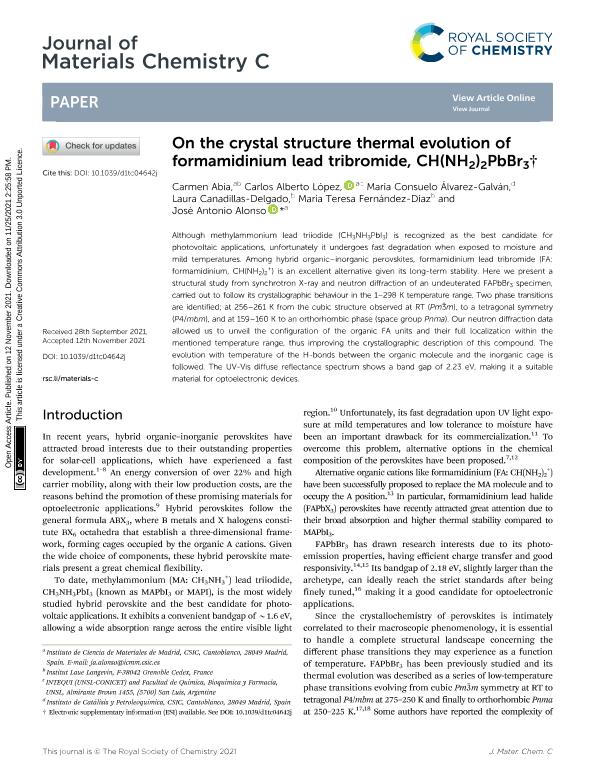Mostrar el registro sencillo del ítem
dc.contributor.author
Abia, Carmen
dc.contributor.author
Lopez, Carlos Alberto

dc.contributor.author
Álvarez Galván, María Consuelo
dc.contributor.author
Canadillas Delgado, Laura
dc.contributor.author
Fernández Díaz, María Teresa
dc.contributor.author
Alonso, José Antonio

dc.date.available
2022-10-04T10:15:07Z
dc.date.issued
2021-11
dc.identifier.citation
Abia, Carmen; Lopez, Carlos Alberto; Álvarez Galván, María Consuelo; Canadillas Delgado, Laura; Fernández Díaz, María Teresa; et al.; On the crystal structure thermal evolution of formamidinium lead tribromide, CH(NH2)2PbBr3; Royal Society of Chemistry; Journal of Materials Chemistry C; 9; 47; 11-2021; 17003-17011
dc.identifier.issn
2050-7534
dc.identifier.uri
http://hdl.handle.net/11336/171595
dc.description.abstract
Although methylammonium lead triiodide (CH3NH3PbI3) is recognized as the best candidate for photovoltaic applications, unfortunately it undergoes fast degradation when exposed to moisture and mild temperatures. Among hybrid organic-inorganic perovskites, formamidinium lead tribromide (FA: formamidinium, CH(NH2)2+) is an excellent alternative given its long-term stability. Here we present a structural study from synchrotron X-ray and neutron diffraction of an undeuterated FAPbBr3 specimen, carried out to follow its crystallographic behaviour in the 1-298 K temperature range. Two phase transitions are identified; at 256-261 K from the cubic structure observed at RT (Pm3m), to a tetragonal symmetry (P4/mbm), and at 159-160 K to an orthorhombic phase (space group Pnma). Our neutron diffraction data allowed us to unveil the configuration of the organic FA units and their full localization within the mentioned temperature range, thus improving the crystallographic description of this compound. The evolution with temperature of the H-bonds between the organic molecule and the inorganic cage is followed. The UV-Vis diffuse reflectance spectrum shows a band gap of 2.23 eV, making it a suitable material for optoelectronic devices.
dc.format
application/pdf
dc.language.iso
eng
dc.publisher
Royal Society of Chemistry

dc.rights
info:eu-repo/semantics/openAccess
dc.rights.uri
https://creativecommons.org/licenses/by/2.5/ar/
dc.subject
CH3NH3PbI3
dc.subject.classification
Química Inorgánica y Nuclear

dc.subject.classification
Ciencias Químicas

dc.subject.classification
CIENCIAS NATURALES Y EXACTAS

dc.title
On the crystal structure thermal evolution of formamidinium lead tribromide, CH(NH2)2PbBr3
dc.type
info:eu-repo/semantics/article
dc.type
info:ar-repo/semantics/artículo
dc.type
info:eu-repo/semantics/publishedVersion
dc.date.updated
2022-03-08T21:06:27Z
dc.identifier.eissn
2050-7526
dc.journal.volume
9
dc.journal.number
47
dc.journal.pagination
17003-17011
dc.journal.pais
Reino Unido

dc.description.fil
Fil: Abia, Carmen. Instituto de Ciencia de Materiales de Madrid; España. Institut Laue Langevin; Francia
dc.description.fil
Fil: Lopez, Carlos Alberto. Consejo Nacional de Investigaciones Científicas y Técnicas. Centro Científico Tecnológico Conicet - San Luis. Instituto de Investigaciones en Tecnología Química. Universidad Nacional de San Luis. Facultad de Química, Bioquímica y Farmacia. Instituto de Investigaciones en Tecnología Química; Argentina. Instituto de Ciencia de Materiales de Madrid; España
dc.description.fil
Fil: Álvarez Galván, María Consuelo. Consejo Superior de Investigaciones Científicas; España
dc.description.fil
Fil: Canadillas Delgado, Laura. Institut Laue Langevin; Francia
dc.description.fil
Fil: Fernández Díaz, María Teresa. Institut Laue Langevin; Francia
dc.description.fil
Fil: Alonso, José Antonio. Instituto de Ciencia de Materiales de Madrid; España
dc.journal.title
Journal of Materials Chemistry C
dc.relation.alternativeid
info:eu-repo/semantics/altIdentifier/url/https://pubs.rsc.org/en/content/articlelanding/2021/TC/D1TC04642J
dc.relation.alternativeid
info:eu-repo/semantics/altIdentifier/doi/https://doi.org/10.1039/D1TC04642J
Archivos asociados
